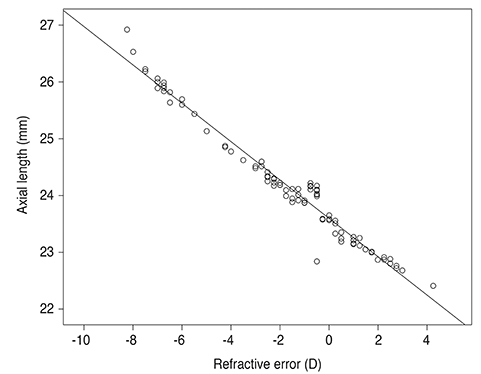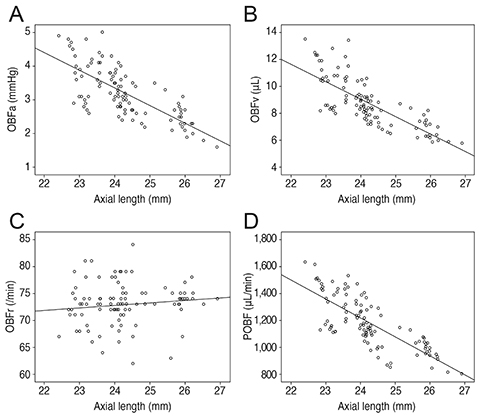Korean J Ophthalmol.
2015 Oct;29(5):309-314. 10.3341/kjo.2015.29.5.309.
Choroidal Blood Flow Change in Eyes with High Myopia
- Affiliations
-
- 1Department of Ophthalmology, Chosun University School of Medicine, Gwangju, Korea. ophkoh@hanmail.net
- KMID: 2363804
- DOI: http://doi.org/10.3341/kjo.2015.29.5.309
Abstract
- PURPOSE
To evaluate choroidal blood flow changes in eyes with high myopia according to the pulsatile components of ocular blood flow analysis.
METHODS
A total of 104 subjects (52 males and 52 females) were included in this study. One eye of each participant was randomly selected and assigned to one of four refractive groups, designated as, hyperopes (n = 20; refractive error, > or =+1.00 diopter [D]), emmetropes (n = 28; refractive error, +/-0.75 D), lower myopes (n = 33; refractive error, -1.00 to -4.75 D), and high myopes (n = 23; refractive error, < or =-5.00 D). Components of pulse amplitude (OBFa), pulse volume (OBFv), pulse rate (OBFr), and pulsatile ocular blood flow (POBF) were analyzed using a blood flow analyzer. Intraocular pressure and axial length were measured.
RESULTS
Pulsatile components of OBFa, OBFv, and POBF showed positive correlations with refractive error and showed negative correlations with axial length (r = 0.729, r = 0.772, r = 0.781, respectively, all p < 0.001; r = -0.727, r = -0.762, r = -0.771, respectively, all p < 0.001). The correlations of refractive error and axial length with OBFr were irrelevant (r = -0.157, p = 0.113; r = 0.123, p = 0.213). High myopes showed significantly lower OBFa, OBFv, and POBF than the other groups (all p < 0.001).
CONCLUSIONS
Axial length changes in high myopes potentially influence choroidal blood flow, assuming the changes are caused by narrowing of the choroidal vessel diameter and increasing rigidity of the choroidal vessel wall. These finding explains the influence of axial length on OBFa, OBFv, and POBF, but not on OBFr. Thus, changes in axial length and the possible influence of these changes on the physical properties of choroidal vessels is the mechanism believed to be responsible for putting high myopes at risk for ocular vascular diseases.
MeSH Terms
Figure
Reference
-
1. Langham ME, Farrell RA, O'Brien V, et al. Blood flow in the human eye. Acta Ophthalmol Suppl. 1989; 191:9–13.2. Perkins ES. The ocular pulse and intraocular pressure as a screening test for carotid artery stenosis. Br J Ophthalmol. 1985; 69:676–680.3. Butt Z, O'brien C. Reproducibility of pulsatile ocular blood flow measurements. J Glaucoma. 1995; 4:214–218.4. Morgan A, Hosking S. Ocular blood flow tonometer reproducibility: the effect of operator experience and mode of application. Ophthalmic Physiol Opt. 2001; 21:401–406.5. Langham ME, Farrell R, Krakau T, Silver DM. Ocular pulsatile blood flow, hypotensive drugs and differential light sensitivity in glaucoma. In : Krieglstein GM, editor. Glaucoma update IV. New York: Springer;1991. p. 162–172.6. Langham ME, Kramer T. Decreased choroidal blood flow associated with retinitis pigmentosa. Eye (Lond). 1990; 4(Pt 2):374–381.7. Mori F, Konno S, Hikichi T, et al. Pulsatile ocular blood flow study: decreases in exudative age related macular degeneration. Br J Ophthalmol. 2001; 85:531–533.8. James CB, Trew DR, Clark K, Smith SE. Factors influencing the ocular pulse: axial length. Graefes Arch Clin Exp Ophthalmol. 1991; 229:341–344.9. Trew DR, James CB, Thomas SH, et al. Factors influencing the ocular pulse: the heart rate. Graefes Arch Clin Exp Ophthalmol. 1991; 229:553–556.10. Ravalico G, Toffoli G, Pastori G, et al. Age-related ocular blood flow changes. Invest Ophthalmol Vis Sci. 1996; 37:2645–2650.11. Ravalico G, Pastori G, Croce M, Toffoli G. Pulsatile ocular blood flow variations with axial length and refractive error. Ophthalmologica. 1997; 211:271–273.12. Mori F, Konno S, Hikichi T, et al. Factors affecting pulsatile ocular blood flow in normal subjects. Br J Ophthalmol. 2001; 85:529–530.13. Benavente-Perez A, Hosking SL, Logan NS, Broadway DC. Ocular blood flow measurements in healthy human myopic eyes. Graefes Arch Clin Exp Ophthalmol. 2010; 248:1587–1594.14. Nickla DL, Wallman J. The multifunctional choroid. Prog Retin Eye Res. 2010; 29:144–168.15. Bynke HG, Schele B. On the origin of the ocular pressure pulse. Ophthalmologica. 1967; 153:29–36.16. Shih YF, Fitzgerald ME, Norton TT, et al. Reduction in choroidal blood flow occurs in chicks wearing goggles that induce eye growth toward myopia. Curr Eye Res. 1993; 12:219–227.17. Hirata A, Negi A. Morphological changes of choriocapillaris in experimentally induced chick myopia. Graefes Arch Clin Exp Ophthalmol. 1998; 236:132–137.18. Cahane M, Bartov E. Axial length and scleral thickness effect on susceptibility to glaucomatous damage: a theoretical model implementing Laplace's law. Ophthalmic Res. 1992; 24:280–284.19. Friedenwald JS. Contribution to the theory and practice of tonometry. Am J Ophthalmol. 1937; 20:985–1024.20. Honmura S. Studies on the relationship between ocular tension and myopia. II. Ocular tension, ocular rigidity, aqueous outflow and aqueous secretion in myopic eyes. Nihon Ganka Gakkai Zasshi. 1968; 72:688–696.21. Sogawa K, Nagaoka T, Takahashi A, et al. Relationship between choroidal thickness and choroidal circulation in healthy young subjects. Am J Ophthalmol. 2012; 153:1129–1132.e1.22. Harris A, Harris M, Biller J, et al. Aging affects the retrobulbar circulation differently in women and men. Arch Ophthalmol. 2000; 118:1076–1080.23. Piltz-Seymour JR. Laser Doppler flowmetry of the optic nerve head in glaucoma. Surv Ophthalmol. 1999; 43:Suppl 1. S191–S198.24. Niwa Y, Yamamoto T, Kawakami H, Kitazawa Y. Reproducibility of color Doppler imaing for orbital arteries in Japanese patients with normal-tension glaucoma. Jpn J Ophthalmol. 1998; 42:389–392.
- Full Text Links
- Actions
-
Cited
- CITED
-
- Close
- Share
- Similar articles
-
- Comment on: Choroidal Blood Flow Change in Eyes with High Myopia
- Subretinal Hemorrhages in High Myopia
- The Relationship among Refractive Power, Axial Length and Choroidal Thickness Measured by SD-OCT in Myopia
- Clinical features of Choroidal Neovascularization in Patient with High Myopia
- Impact of Myopia Progression and Its Intervention Methods on Choroidal Thickness





